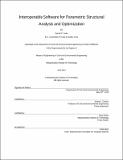Interoperable software for parametric structural analysis and optimization
Author(s)
Jones, Garrett P. (Garrett Pierce)
DownloadFull printable version (4.628Mb)
Other Contributors
Massachusetts Institute of Technology. Department of Civil and Environmental Engineering.
Advisor
Jerome J. Connor.
Terms of use
Metadata
Show full item recordAbstract
The advent of building information modeling in the structural engineering profession has brought forth new challenges to the traditional methods of design and analysis. The need for faster, more robust analyses to mitigate expenses and increase structural insight is a demand that stems from the implementation of BIM modeling. Current software interoperability now allows engineers limited opportunity to engage directly and immediately with the design process. The development of tools which can bring together the architectural and structural engineering professions are of paramount importance in the next phase of professional design. In response to this professional demand, a software framework for Rhino3D modeling software was created which explores the various methods of searching a design space and finding solutions. Both parametric design generation and genetic optimizations were employed, allowing architects and engineers to explore the design space of a structure using metrics important to each field. A case study is performed using the developed software framework to quantify results and validate the effectiveness of such a new design tool in the current engineering profession. The outcome is an improved design experience that is feasible in time and scope, allowing architects and engineers an opportunity to truly explore the design space. Keywords: Parametric modeling and analysis, Genetic optimization, Building information modeling
Description
Thesis (M. Eng.)--Massachusetts Institute of Technology, Dept. of Civil and Environmental Engineering, 2013. This electronic version was submitted by the student author. The certified thesis is available in the Institute Archives and Special Collections. Cataloged from student-submitted PDF version of thesis. "June 2013." Includes bibliographical references (p. 62-64).
Date issued
2013Department
Massachusetts Institute of Technology. Department of Civil and Environmental EngineeringPublisher
Massachusetts Institute of Technology
Keywords
Civil and Environmental Engineering.